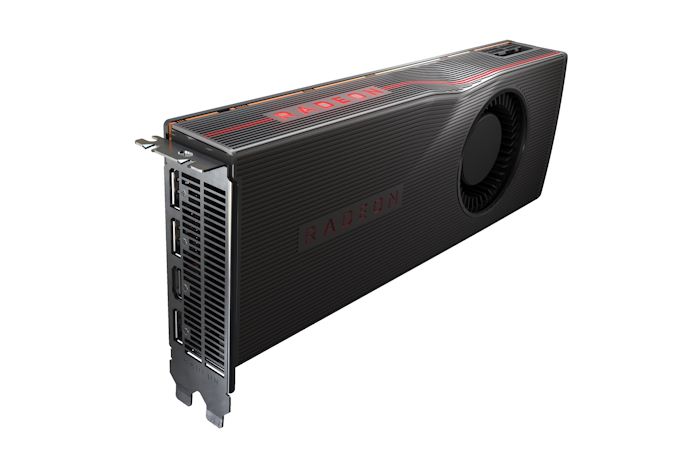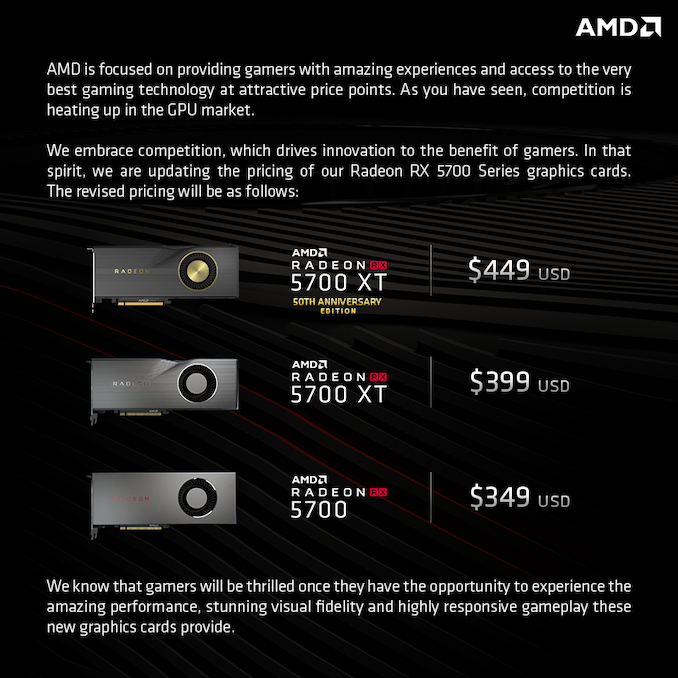AMD Adjusts Launch Price of Radeon RX 5700 Series: XT Down To $399, Standard Down To $349
by Andrei Frumusanu on July 5, 2019 5:30 PM EST- Posted in
- AMD
- GPUs
- Navi
- Radeon RX 5700

The new Radeon RX 5700 hasn’t even yet officially launched as we’re still awaiting Sunday the 7th of July, yet AMD in a rare event has now officially announced that is it adjusting the launch prices of the new Navi cards to lower price points.
Originally, the Radeon 5700 XT Anniversary edition, the XT, and the standard variant were priced at $499, $449, and $379. AMD has now lowered the price points to $449, $399 and $349.
| AMD Radeon RX Series Specification Comparison | ||||||
| AMD Radeon RX 5700 XT | AMD Radeon RX 5700 | AMD Radeon RX 590 | AMD Radeon RX 570 | |||
| Stream Processors | 2560 (40 CUs) |
2304 (36 CUs) |
2304 (36 CUs) |
2048 (32 CUs) |
||
| Texture Units | 160 | 144 | 144 | 128 | ||
| ROPs | 64 | 64 | 32 | 32 | ||
| Base Clock | 1605MHz | 1465MHz | 1469MHz | 1168MHz | ||
| Game Clock | 1755MHz | 1625MHz | N/A | N/A | ||
| Boost Clock | 1905MHz | 1725MHz | 1545MHz | 1244MHz | ||
| Throughput (FP32) | 9.75 TFLOPs | 7.9 TFLOPs | 7.1 TFLOPs | 5.1 TFLOPs | ||
| Memory Clock | 14 Gbps GDDR6 | 14 Gbps GDDR6 | 8 Gbps GDDR5 | 7 Gbps GDDR5 | ||
| Memory Bus Width | 256-bit | 256-bit | 256-bit | 256-bit | ||
| VRAM | 8GB | 8GB | 8GB | 4GB | ||
| Transistor Count | 10.3B | 10.3B | 5.7B | 5.7B | ||
| Typical Board Power | 225W | 180W | 225W | 150W | ||
| Manufacturing Process | TSMC 7nm | TSMC 7nm | GloFo/Samsung 12nm | GloFo 14nm | ||
| Architecture | RDNA (1) | RDNA (1) | GCN 4 | GCN 4 | ||
| GPU | Navi 10 | Navi 10 | Polaris 30 | Polaris 10 | ||
| Launch Date | 07/07/2019 | 07/07/2019 | 11/15/2018 | 08/04/2016 | ||
| Launch Price | $399 |
$349 |
$279 |
$179 |
||
The move isn’t unprecedented, but is something extremely rare. What is interesting is that AMD’s Scott Herkelman (CVP & GM AMD Radeon) yesterday posted an interesting but short tweet:
Jebaited
— Scott Herkelman (@sherkelman) July 4, 2019
Scott's snarky tweet is suggesting AMD had planned the move all along- playing a bait & switch in terms of the pricing of the RX 5700, most likely in preparation and in response to Nvidia’s newest Super card line-up.
We’re looking forward to covering the RX 5700 series cards when the time comes – hopefully soon!
Related Reading
Source: @Radeon on Twitter











78 Comments
View All Comments
Someguyperson - Friday, July 5, 2019 - link
The Navi chips are so small that AMD could drop the prices even more and still make a profit. It just makes sense to keep the prices as close to being competitive with Nvidia to increase profit margins as much as possible.imaheadcase - Friday, July 5, 2019 - link
Most of the price of chips isn't that though, its the R&D to develop them. As with most things hardware, having a good software and design makes or break a product in the end.Smell This - Saturday, July 6, 2019 - link
►Je-BaitedIt's Jerry Sanders golden anniversary. Fork R&D; we're gonna party.
It's in AMD's **RDNA** to lead in price/performance.
What Guachi says ...
""They should rename the 50th anniversary edition the LISA SUper edition.""
(guachi - Saturday, July 06, 2019)
HA!
Dark42 - Saturday, July 6, 2019 - link
But R&D is a one-time effort.Therefore AMD can keeps the prices lower than Nvidia and still make bigger profits than with higher prices because of bigger volume.
Irata - Saturday, July 6, 2019 - link
Yes, but you still need to amortize the R&D expenses. Otherwise, there is no money to develop the next generation.Dug - Saturday, July 6, 2019 - link
"But R&D is a one-time effort."No it's not. At least if you want to keep good employees.
Opencg - Saturday, July 6, 2019 - link
amd did only develop one microprocessor for the navi launch. as well the tensor and rt cores are not really helping mainstream performance so nvidia is footing the bill for extra silicon per fps.although nvidia was able to set high prices on the rtx cards for over half a year due to limited competition from amd.
both companies are likely doing fine right now. excited to see how navi stacks up vs super in a few hours. and glad that gpus are returning to sane prices. although some real forward progress has not happened since pascal
Korguz - Saturday, July 6, 2019 - link
" and glad that gpus are returning to sane prices " they are ??? doesnt look like itSantoval - Saturday, July 6, 2019 - link
The Navi dies might be quite smaller but TSMC's 7nm wafers are also much more expensive, while the yields are typically lower than of wafers fabbed on more mature nodes. And that's without even taking into account the higher development and design costs of CPUs/GPUs based on smaller nodes.You almost make it sound like : 1/2 the die area => twice the number of dies per wafer => 1/2 the cost per die => double the profit per die, when the reality is not anywhere close to that.
Audacioucity - Saturday, July 6, 2019 - link
https://caly-technologies.com/die-yield-calculator...Try it yourself. Per wafer, even assuming a defect density four times of the mature 12nm, AMD is still getting more good dies. There's no way a process with a defect density that bad can be used for mass production. It's a conservative estimation to prove my point. Even though it's nowhere near 1/2 the production cost, it might still be a meaningful advantage for AMD.
Also, it should be noted that a common narrative nowadays is that AMD is the only one who's able to slash prices. In reality, it is more likely that both can drop prices and still make a comfortable profit margin as it is historically the case. A 200-300 mm2 card on a leading-edge process should never cross $320. Polaris launched $250 on what was a leading-edge process then. There's no way that 7nm and GDDR6 alone adds $70 on production cost.